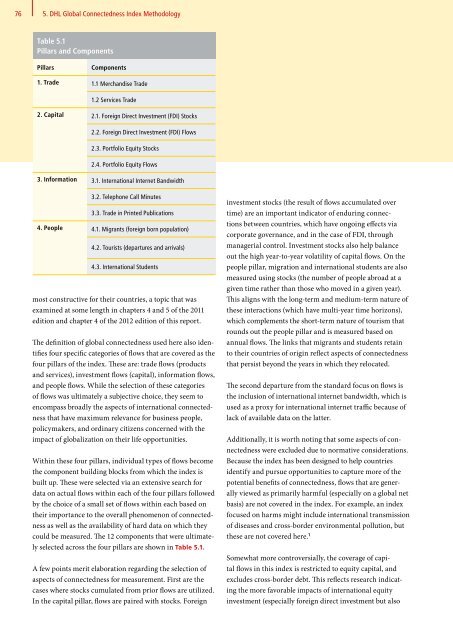DHL Global Connectedness Index 2014
DHL Global Connectedness Index 2014
DHL Global Connectedness Index 2014
- No tags were found...
Create successful ePaper yourself
Turn your PDF publications into a flip-book with our unique Google optimized e-Paper software.
76 5. <strong>DHL</strong> <strong>Global</strong> <strong>Connectedness</strong> <strong>Index</strong> Methodology<br />
Table 5.1<br />
Pillars and Components<br />
Pillars<br />
Components<br />
1. Trade 1.1 Merchandise Trade<br />
1.2 Services Trade<br />
2. Capital 2.1. Foreign Direct Investment (FDI) Stocks<br />
2.2. Foreign Direct Investment (FDI) Flows<br />
2.3. Portfolio Equity Stocks<br />
2.4. Portfolio Equity Flows<br />
3. Information 3.1. International Internet Bandwidth<br />
3.2. Telephone Call Minutes<br />
3.3. Trade in Printed Publications<br />
4. People 4.1. Migrants (foreign born population)<br />
4.2. Tourists (departures and arrivals)<br />
4.3. International Students<br />
most constructive for their countries, a topic that was<br />
examined at some length in chapters 4 and 5 of the 2011<br />
edition and chapter 4 of the 2012 edition of this report.<br />
The definition of global connectedness used here also identifies<br />
four specific categories of flows that are covered as the<br />
four pillars of the index. These are: trade flows (products<br />
and services), investment flows (capital), information flows,<br />
and people flows. While the selection of these categories<br />
of flows was ultimately a subjective choice, they seem to<br />
encompass broadly the aspects of international connectedness<br />
that have maximum relevance for business people,<br />
policymakers, and ordinary citizens concerned with the<br />
impact of globalization on their life opportunities.<br />
Within these four pillars, individual types of flows become<br />
the component building blocks from which the index is<br />
built up. These were selected via an extensive search for<br />
data on actual flows within each of the four pillars followed<br />
by the choice of a small set of flows within each based on<br />
their importance to the overall phenomenon of connectedness<br />
as well as the availability of hard data on which they<br />
could be measured. The 12 components that were ultimately<br />
selected across the four pillars are shown in Table 5.1.<br />
A few points merit elaboration regarding the selection of<br />
aspects of connectedness for measurement. First are the<br />
cases where stocks cumulated from prior flows are utilized.<br />
In the capital pillar, flows are paired with stocks. Foreign<br />
investment stocks (the result of flows accumulated over<br />
time) are an important indicator of enduring connections<br />
between countries, which have ongoing effects via<br />
corporate governance, and in the case of FDI, through<br />
managerial control. Investment stocks also help balance<br />
out the high year-to-year volatility of capital flows. On the<br />
people pillar, migration and international students are also<br />
measured using stocks (the number of people abroad at a<br />
given time rather than those who moved in a given year).<br />
This aligns with the long-term and medium-term nature of<br />
these interactions (which have multi-year time horizons),<br />
which complements the short-term nature of tourism that<br />
rounds out the people pillar and is measured based on<br />
annual flows. The links that migrants and students retain<br />
to their countries of origin reflect aspects of connectedness<br />
that persist beyond the years in which they relocated.<br />
The second departure from the standard focus on flows is<br />
the inclusion of international internet bandwidth, which is<br />
used as a proxy for international internet traffic because of<br />
lack of available data on the latter.<br />
Additionally, it is worth noting that some aspects of connectedness<br />
were excluded due to normative considerations.<br />
Because the index has been designed to help countries<br />
identify and pursue opportunities to capture more of the<br />
potential benefits of connectedness, flows that are generally<br />
viewed as primarily harmful (especially on a global net<br />
basis) are not covered in the index. For example, an index<br />
focused on harms might include international transmission<br />
of diseases and cross-border environmental pollution, but<br />
these are not covered here. 1<br />
Somewhat more controversially, the coverage of capital<br />
flows in this index is restricted to equity capital, and<br />
excludes cross-border debt. This reflects research indicating<br />
the more favorable impacts of international equity<br />
investment (especially foreign direct investment but also





